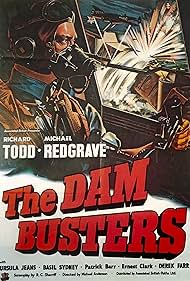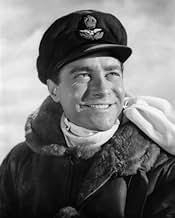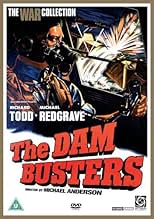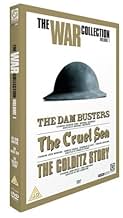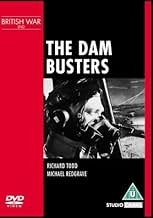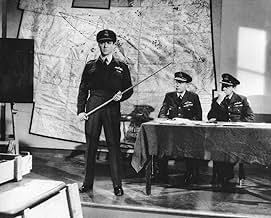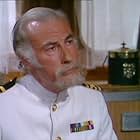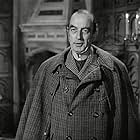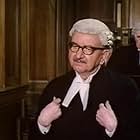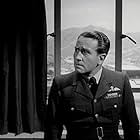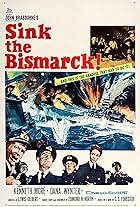Drama based on the attempt by the RAF to destroy six dams in Germany during World War II.Drama based on the attempt by the RAF to destroy six dams in Germany during World War II.Drama based on the attempt by the RAF to destroy six dams in Germany during World War II.
- Nominated for 1 Oscar
- 4 nominations total
- Director
- Writers
- All cast & crew
- Production, box office & more at IMDbPro
Storyline
Did you know
- TriviaThere was no follow-up raid because aerial photography showed that the new anti-air raid defences on the dam installed after the attack would have made a second raid suicidal.
- GoofsThe system devised to get the height right was, in the film, said to have been thought of by the 617 Sqn crews following a visit to the theater. In reality it was devised by the 'boffins' at Farnborough.
- Quotes
Official, Ministry of Aircraft Production: You say you need a Wellington Bomber for test drops. They're worth their weight in gold. Do you really think the authorities will lend you one? What possible argument could I put forward to get you a Wellington?
Doctor B. N. Wallis, C.B.E., F.R.S.: Well, if you told them I designed it, do you think that might help?
- Crazy creditsBlu-Ray edition opening screen: "While we acknowledge some of the language used in The Dam Busters reflects historical attitudes audiences may find offensive, for reasons of historical accuracy we have opted to present the film as it was originally screened."
This refers to the fact that the protagonist, Wing Commander Guy Penrose Gibson's, dog is named "N-Word." In addition, the dog's name is used during the raid on the dams as code indicating the dam(s) have successfully been breached.
- Alternate versionsPrints distributed in the United States by Warner Brothers added a shot from Desperate Journey (1942) showing an early model B-17 Flying Fortress crashlanding in a forest.
- ConnectionsEdited into Attack on the Iron Coast (1968)
Featured review
In the spring of 1942, the English design engineer, Barnes Wallis, is working on a revolutionary new bomb, capable of breaching Germany's hydro-electric dams. This film, with its unforgettable "Dam Busters March" by Eric Coates, recounts the story of the development of the bomb and the devising of special tactics for attacking Germany's industrial heartland. It is also a tribute to the genius of Wallis and the courage and skill of the men who made the concept work.
The great dams of western Germany, harnessing the energy of the rivers Moehne, Eder and Sorbe, were an important power source for the Nazi war effort. If the dams could be breached, then the loss of electrical energy and the collateral flooding would, it was hoped, cripple German industry and shorten the war.
As the film opens, Wallis is pondering the one central problem associated with bombing a dam. Any explosion in the water (and direct hits on the dam wall are too much to expect) is cushioned by the fluidity, and no structural damage results.
We see Wallis eagerly experimenting in his back yard, surrounded and assisted by his adoring children. His brilliant idea is this - if a bomb can be delivered at the correct shallow trajectory and the right high speed, it will 'skip' along the lake's surface like a pebble on a pond, strike the dam and slide down the wall. A depth-sensitive trigger could then detonate the bomb where it would do maximum damage.
The idea is a daring and imaginative one, and predictably enough, the various government departments are slow to see its merit. Wallis spends many disheartening hours waiting to speak to unsympathetic civil servants. In a lovely piece of ironic humour, a Whitehall mandarin points out to Wallis the difficulties inherent in obtaining a Wellington bomber for tests, and Wallis quietly suggests that his own role as the creator of the Wellington might be of some assistance.
Wallis is constantly being told that resources are scarce, that the communal effort requires sacrifices, and so forth. There is, he is told, "a very thin dividing line between inspiration and obsession". However, the eccentric genius persists, and eventually Churchill gets to hear of the idea. From that moment on, the project gathers momentum. 'Bomber' Harris, the chief of Britain's Bomber Command, sets up trials. The 'bouncing bomb' is at last a reality.
Major disappointments accompany the trials. The casing of the bomb has to be drastically re-designed, and it transpires that the aircraft will need to approach the dam considerably lower and faster than had been envisaged. The RAF's standard altimeters are useless at heights of 50 feet, and the resulting danger to crews of flying blind at almost zero altitude are unacceptable.
At this point, Commander Guy Gibson, the pilot who will lead the raid, has his own flash of inspiration. The spotlights in a variety theatre give him the idea of two converging light beams, shining downwards from aircraft to water, which will fix the plane's altitude precisely. If this all sounds a little 'Heath Robinson', it is nothing compared to the viewing gadget which is cobbled together to enable crews to align on the twin towers of the dam.
The climax of the film, the actual attack on the German dams, is rather a disappointment. Anti-aircraft tracer coming up from the German defenders is superimposed on the photographic matrix in the most amateurish of ways. The sound of the ground batteries is unrealistic, staying at a constant pitch and volume however the aircraft manoeuvre. The explosions are the poorest efforts of all, being no more than scraps of film and drawings, patched unconvincingly onto shots of a model dam.
Michael Redgrave does a commendable job of 'creating' Barnes Wallis for the screen, quintessentially English and understated, with his runner beans and his cricket jokes. The man's boyish enthusiasm comes across. In this respect the bathtub in the yard, the setting for his primitive experiments, serves two cinematic purposes, showing us the simple, unprepossessing genius of the English people, and explaining in visual terms exactly how the bomb will work.
Good use is made of genuine Air Ministry film of the bouncing bomb tests. If the ultimate effect on Germany's war capacity is exaggerated, this can be forgiven.
Richard Todd is terrific as Gibson, the tough little leader of the mission, the emotional man who is able through intense self-discipline to keep his feelings in check and do his duty. The powerful ending is almost too much to take, with the empty seats in the officers' mess, and Todd striding off in stiff-upper-lip fashion to 'write a few letters'. No English heart can fail to be stirred by that marvellous theme tune.
The great dams of western Germany, harnessing the energy of the rivers Moehne, Eder and Sorbe, were an important power source for the Nazi war effort. If the dams could be breached, then the loss of electrical energy and the collateral flooding would, it was hoped, cripple German industry and shorten the war.
As the film opens, Wallis is pondering the one central problem associated with bombing a dam. Any explosion in the water (and direct hits on the dam wall are too much to expect) is cushioned by the fluidity, and no structural damage results.
We see Wallis eagerly experimenting in his back yard, surrounded and assisted by his adoring children. His brilliant idea is this - if a bomb can be delivered at the correct shallow trajectory and the right high speed, it will 'skip' along the lake's surface like a pebble on a pond, strike the dam and slide down the wall. A depth-sensitive trigger could then detonate the bomb where it would do maximum damage.
The idea is a daring and imaginative one, and predictably enough, the various government departments are slow to see its merit. Wallis spends many disheartening hours waiting to speak to unsympathetic civil servants. In a lovely piece of ironic humour, a Whitehall mandarin points out to Wallis the difficulties inherent in obtaining a Wellington bomber for tests, and Wallis quietly suggests that his own role as the creator of the Wellington might be of some assistance.
Wallis is constantly being told that resources are scarce, that the communal effort requires sacrifices, and so forth. There is, he is told, "a very thin dividing line between inspiration and obsession". However, the eccentric genius persists, and eventually Churchill gets to hear of the idea. From that moment on, the project gathers momentum. 'Bomber' Harris, the chief of Britain's Bomber Command, sets up trials. The 'bouncing bomb' is at last a reality.
Major disappointments accompany the trials. The casing of the bomb has to be drastically re-designed, and it transpires that the aircraft will need to approach the dam considerably lower and faster than had been envisaged. The RAF's standard altimeters are useless at heights of 50 feet, and the resulting danger to crews of flying blind at almost zero altitude are unacceptable.
At this point, Commander Guy Gibson, the pilot who will lead the raid, has his own flash of inspiration. The spotlights in a variety theatre give him the idea of two converging light beams, shining downwards from aircraft to water, which will fix the plane's altitude precisely. If this all sounds a little 'Heath Robinson', it is nothing compared to the viewing gadget which is cobbled together to enable crews to align on the twin towers of the dam.
The climax of the film, the actual attack on the German dams, is rather a disappointment. Anti-aircraft tracer coming up from the German defenders is superimposed on the photographic matrix in the most amateurish of ways. The sound of the ground batteries is unrealistic, staying at a constant pitch and volume however the aircraft manoeuvre. The explosions are the poorest efforts of all, being no more than scraps of film and drawings, patched unconvincingly onto shots of a model dam.
Michael Redgrave does a commendable job of 'creating' Barnes Wallis for the screen, quintessentially English and understated, with his runner beans and his cricket jokes. The man's boyish enthusiasm comes across. In this respect the bathtub in the yard, the setting for his primitive experiments, serves two cinematic purposes, showing us the simple, unprepossessing genius of the English people, and explaining in visual terms exactly how the bomb will work.
Good use is made of genuine Air Ministry film of the bouncing bomb tests. If the ultimate effect on Germany's war capacity is exaggerated, this can be forgiven.
Richard Todd is terrific as Gibson, the tough little leader of the mission, the emotional man who is able through intense self-discipline to keep his feelings in check and do his duty. The powerful ending is almost too much to take, with the empty seats in the officers' mess, and Todd striding off in stiff-upper-lip fashion to 'write a few letters'. No English heart can fail to be stirred by that marvellous theme tune.
Details
- Release date
- Country of origin
- Language
- Also known as
- The Dambusters
- Filming locations
- Production company
- See more company credits at IMDbPro
Box office
- Gross worldwide
- $84,627
- Runtime1 hour 45 minutes
- Color
Contribute to this page
Suggest an edit or add missing content

